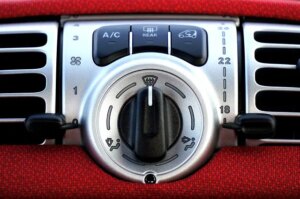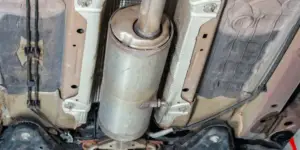Here we look at what can make your car air con blow hot air and the repair costs.
Car air-con system repairs are the job of the professionals. It’s not so much that replacing the parts is difficult but that the gas used in air-con systems called Freon is toxic and can harm humans.

Freon must be disposed of by a certified technician and can’t be dumped with normal garbage.
There are six causes as to why you’re getting hot air rather than the air-conditioned cooling breeze you were expecting.
We’ll explore the causes – briefly, we won’t blind you with technical stuff, the fixes, and probably the most important part, the costs of putting it right.
The most likely cause is that your AC Freon level is low and needs to be recharged or that your AC system has a leak. Less likely causes are a condenser or compressor has broken and needs replacing.
In a little bit more detail and starting with the most likely cause through to rarer causes
The Reasons Your AC Is Blowing Hot Air In Your Car
1. Low Refrigerant or Leaking Refrigerant
In a completely airtight A/C system, the Freon gas would continue to do its job indefinitely. It doesn’t become less effective over time; in theory, your air-con system would never need to be recharged.
Unfortunately, there are quite a few car parts that Freon travels through, including the compressor and condenser, as well as hoses. Not only that, but it also changes from liquid to gas and is kept in a pressurized system.
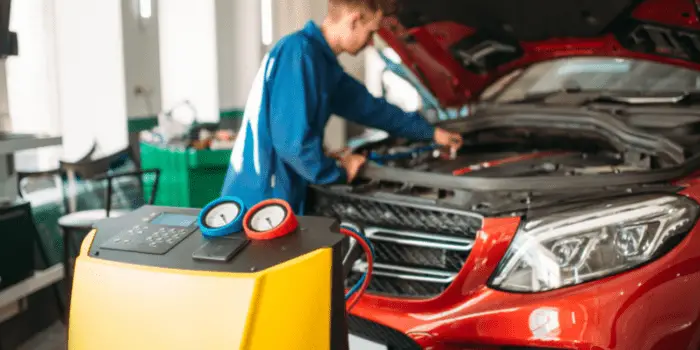
All these factors make leaking a common issue with car A/C systems, and when they occur, the pressure difference between the system and normal air pressure results in the Freon being forced out of the system.
You can’t see or smell Freon escaping as it’s an odorless and colorless gas. If it leaks in liquid form, you may see a small area of fluid under the car’s engine bay, but this is unusual.
You may hear a hissing noise coming from under the hood, but often most of the gas escapes so quickly, and often, ahen you’re not around the car, you may not hear it.
If you are mechanically minded, you can test the system for leaks, which will mean buying an electronic refrigerant detector.
This works by detecting the smallest amount of refrigerant in the air under your hood. You move the hose over the parts, and if Freon – refrigerant – is detected, it beeps.
Another cheaper option is to use a die can that will stain the hoses or other parts if a leak is present. You spray the can around the compressor, condenser, and hoses and look for areas of staining.
Even if you find the leak – and are happy to replace the part that’s leaking – you will have to go to an approved A/C specialist to recharge the system with gas. You can’t buy this gas unless you are approved. It’s the law, and details can be read over at the EPA website.
The leak will likely be from the hoses that run between your compressor and condenser, which is a cheap fix.
Expect to pay between $75 and $150 for an AC hose replacement. This cost should include leak detection and labor costs too.
The cost of recharging the AC system is between $125 and $325, depending on the make and model of your car and the mechanic’s labor rates.
2. Electrical System Malfunction
Your car’s ECU – computer – receives signals from many sensors throughout your car. It then reacts to the information it’s been given. Often, a sensor will go bad and feed it the wrong information. This can happen within the A/C system and cause the ECU to shut the system down completely.
The sensor that can go wrong in your car’s AC system is behind the evaporator at the front of your engine. Unfortunately, there is no way to know if the sensor is bad unless you can read a fault code stored in your car’s ECU.

For this, you need an OBD fault reader. They cost about $30 and will alert you to any faults with your car when plugged into your car. They are a great bit of kit and can save you money on car shop diagnostic checks.
If you have one already, plug it into your car – refer to your handbook where it needs to be plugged- and read off any codes.
The code P0539 is for an intermittent Evaporator Temperature Sensor.
A replacement costs between $125 and $300 including the part and labor. The part costs between $75 and $150 and labor costs vary between $50 and $150.
3. Condensor Is Bad
The AC condenser in your car is an expensive part and works under high pressure. Its job is to condense the gases -that have been sent to it from the compressor – back to a liquid. Warm air is blown over the compressor by your car fan; it gets cooled before arriving in your car through the vents.
You can find your car’s condenser is located next to your car fan, and if it’s faulty, you may be able to see a Freon leak there if the leak is bad enough.
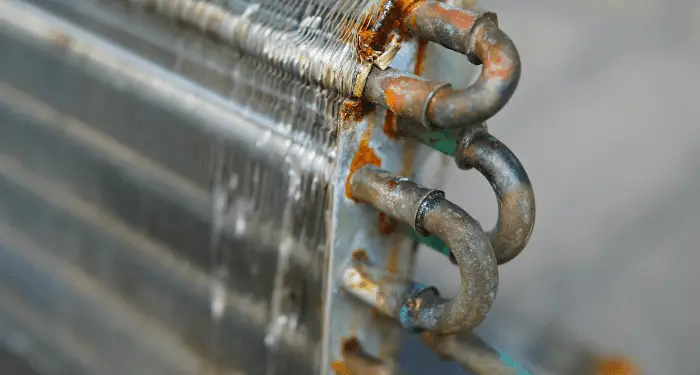
Car air condensers should last the lifetime of a car, but as with any car part, the more it is used, the more likely it is to wear out and need replacing.
Expect to pay between $300 to $750 to have your car’s condenser replaced. This includes labor. The price variance is due to the costlier parts of some more luxury-end vehicles.
4. Compressor Is Broken
The compressor is the most expensive part of your car’s A/C system. There are a lot of moving parts that work under high pressure and temperatures. It is powered by a belt that runs from the crank and has a clutch plate and bearings inside it. Your Aircon can make many different noises but a bad condenser can make a grinding noise, among others.
There are a lot of parts that can go wrong within it. Look for a large metal part with a rubber belt attached to it by the side of the engine, as that is where most compressors are situated.

This isn’t a repair most people could attempt even if there weren’t the Freon disposal problem to deal with.
If you do hear a noise, your compressor may be salvageable. It depends on what part within it has failed. It isn’t easy to know until the mechanic gets to strip it back and inspect it, it isn’t easy to know.
Often though, the labor rate to fix a condenser makes buying a brand new one the cheaper option.
The cost to replace a car A/C compressor ranges between $800 and $1250 depending on the make and model of the car. This should include the cost of a Freon recharge too.
5. Blown AC Fuse
If your fuse has blown, it’s potentially the cheapest fix. You’ll need to open the fuse box lid and look at the diagram to locate the AC fuse.
The fuse is normally a 10 amp standard one, and you may have a spare -n the fuse box. If you don’t, take a fuse from another circuit – one that isn’t needed to start the car- and swap it over. If the aircon comes on and blows cold air, you’ve fixed it.
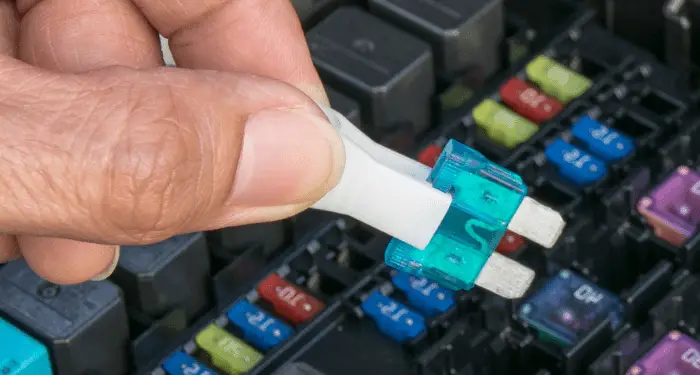
However, if you replace the fuse and it happens again, this will signify something wrong with the AC electrical circuit. This will require further investigation.
6. Broken Cooling Fan
I know, not connected to the air con, but if this isn’t working, your AC can be doing its job wonderfully, but no warm air is being forced past the condenser to cool down.
A really easy check this one. Open the hood and see if the fan at the front of the engine fan is rotating. If not, then this could be the culprit. Ensure the engine is hot; otherwise, it wouldn’t be turning anyway.
There are a few reasons why the fan isn’t working. The fan switch may be stuck off, the relay in the fuse box may be bad – some cars have two fuses, a high fan and a low fan – or the blades are damaged and not turning.
It’s always worth checking the relay if your fan isn’t working. The relays are the black or silver boxes in your fuse box. Most cars have 6 – 10 of these, and they are interchangeable along as they have the same part number.
Locate the fan relay and swap it out with another relay from a system that isn’t being used and see if the fan works. If it comes to life, you know it was the relay.
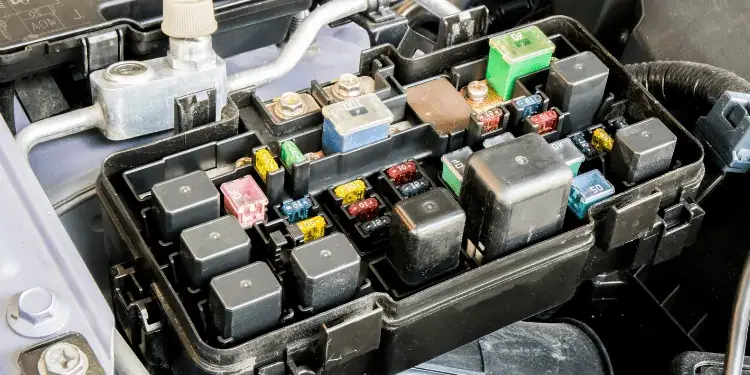
These are very cheap to buy. Expect to pay around $15 for one, but sometimes a tap on the top of it can free them up and get them working again.
In Summary
Frequent causes of hot air blowing from your car’s aircon are a refrigerant problem, most particularly, a refrigerant leak. Your car’s refrigerant levels may be too low, or there may be a leak creating this refrigerant loss.
Generally, the hoses are bad, and they are a cheap fix, although you’ll still need a recharge to get the AC working again.
Other AC parts that may have failed are the compressor and the condenser. These parts can be expensive to fix, and often having a brand new part fitted is cheaper than repairing the existing one.
The remaining causes are all electrical, whether a bad AC temperature sensor, a relay, or a fuse blowing, and are less common.
Some people decide to try and survive without AC when it stops working but soon end up wishing they invested the time and the money in getting it fixed when the mercury rises in the middle of the summer!




